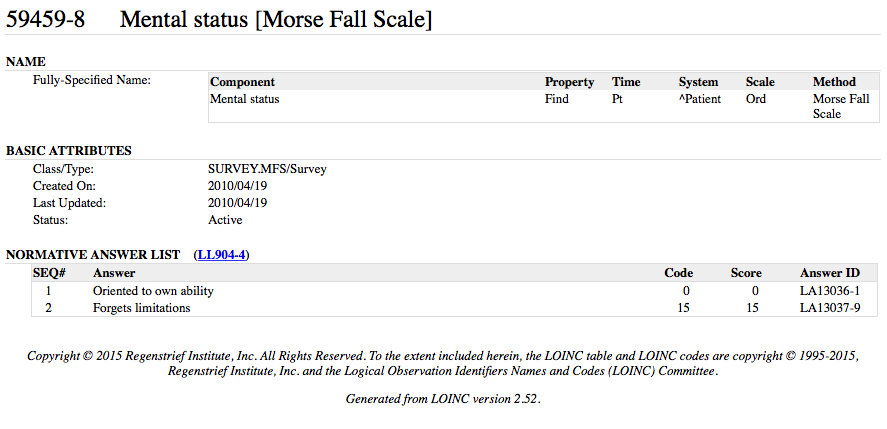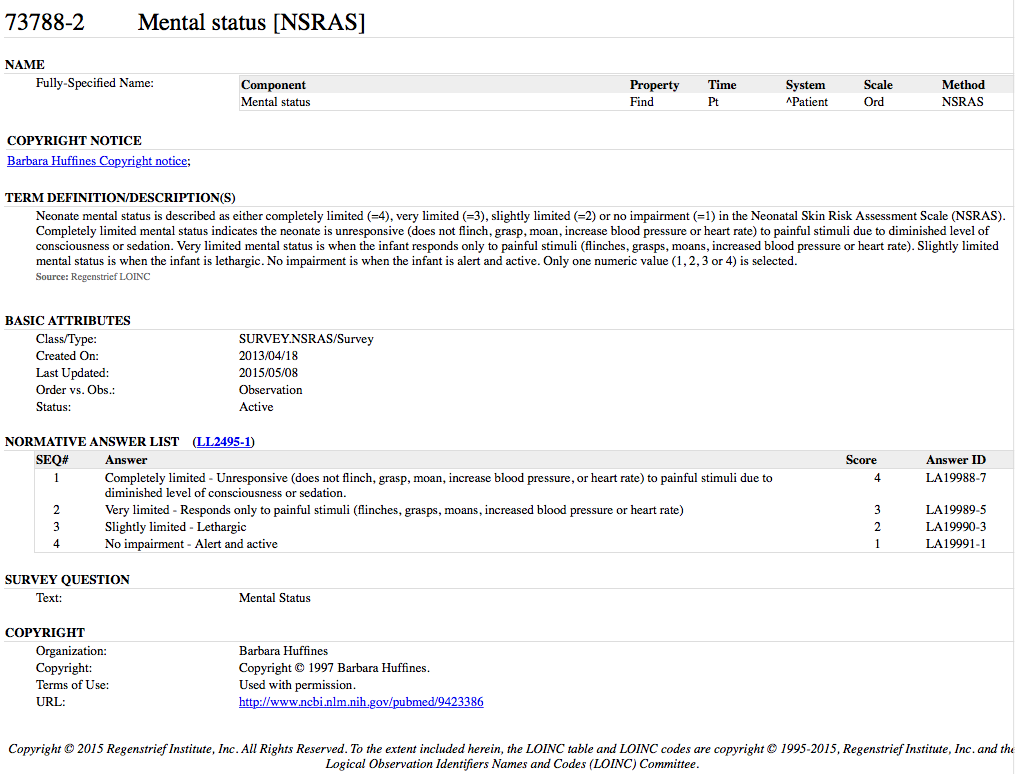LOINC is widely used as a vocabulary standard for laboratory observations. It’s less well known that LOINC has large body of content covering standardized patient assessments, like patient reported outcomes measures, survey instruments, and other kinds of questions on standardized forms.
In fact, over the years, LOINC has developed a robust data model for this content that represents the questions, answer lists, and organization of the whole form. There are now more than 10,000 such variables in LOINC, including CMS-required instruments like MDSv3 and OASIS-C, the PHQ-9, the NIH Stroke Scale, Morse Fall Scale, APTA’s OPTIMAL instrument, PROMIS, etc.
Having patient assessments in LOINC makes it possible to exchange these data across information systems and care settings. Another great benefit of having a uniform representation of these instruments is that you can build data entry forms easily. One great example is the open source LForms tool. Another is the Regenstrief ePRO platform we’re building that uses OpenMRS.
When people discover the treasure trove of this content in LOINC, they often ask:
When is it ok to reuse a LOINC question from an existing instrument?

photo via Kevin Dooley
What do you mean by {smoking status}?
The overall idea is that you should use an existing LOINC code when your intended meaning of the observation concept is the same as the original meaning of the term. In other words, if you are asking the question in the same exact way (same question text, same answer list, etc) you should use the existing LOINC code. That’s the whole point of having these variables in LOINC.
For example, when the American Physical Therapy Association was choosing terms for their national outcomes registry project, they wanted to include a variable to represent “smoking status”. There are a million ways one could possibly record smoking status. Pack years, cigarettes per day, duration of exposure, ever smoked?, age you first started smoking, etc.
But they wanted participants to capture this data according to CDC’s recommended categories: Current every day smoker, Current some day smoker, etc. These are also the categories required in Meaningful Use. So, APTA wisely elected not to make up their own way to record smoking status, but rather to re-use the existing term:
Here, “NHIS” means CDC’s National Health Interview Survey. That survey is authoritative source that defined this specific approach to recording smoking status.
So, you might be wondering…
How do I know if a LOINC code is from a patient assessment instrument?
The Method is key
Well, the main clue is that its Method type (the 6th part of the LOINC name) is the name of an instrument. For example, notice how these terms look very similar, except that they vary in the Method:
| LOINC | Component | Property | Time | System | Scale | Method |
| 59459-8 | Mental status | Find | Pt | ^Patient | Ord | Morse Fall Scale |
| 73788-2 | Mental status | Find | Pt | ^Patient | Ord | NSRAS |
LOINC uses the Method to distinguish the technique by which the observation was made. Here, the technique is the specific instrument. So, you can’t just assume that because the Component has the same words as your concept, you can use that LOINC term. You need to pay attention to the Method.
The two terms above would not be appropriate for some generic mental status observation where clinicians could record whatever they wanted. These terms are specific to the named instruments.
A note about provenance
LOINC uses the Method as a clue about the provenance of the technique. Namely, to identify who is the authoritative body that defined how this observation should be made. In assigning a method, LOINC uses a “first in” approach. That is, we try to track back to an originating source when defining the Method.
Later, if another instrument or data set decides to use this same approach, we would re-use the original LOINC code (with the original method name) in the panel for that set. So that’s why you might see terms with the Method of BIMS (Brief Interview for Mental Status) inside the MDS panel.
Am I doing it the same way?
So the Method indicates the technique. To determine if you are doing it the same as the original source, you need to look at a) how the question was asked, b) what is the set of allowed answers, and c) any other special context.
Asking the question
Before using a LOINC code with an assessment instrument method, you want to be sure that you are asking the question in the same way. Different question texts can have very different psychometric properties, so this is a key distinction.
LOINC captures the way a variable appears on the form (or how the question was asked).
The Component of a LOINC term represents the thing or attribute being measured, and is the default for capturing the item text. But, there are a few reasons why the Component might not be the exact question text (see section Choosing the “display text” for a question or variable in the LOINC Users’ Guide). If the item is asked as an actual question, LOINC stores that text in the SURVEY_QUEST_TEXT field of the LOINC table.
In RELMA and on search.loinc.org, the details pages will show the question text under the Survey Question section. For example, here is the section of the details page for the term [68245-0] It was hard for me to play or hang out with my friends when I had pain in the past 7 days [NeuroQol.Peds]

Source: Regenstrief institute
Sometimes, there really isn’t much “question text”, the item is more like just a variable name. This is the case with the two mental status items above. This is why you must also always consider the set of allowed answers.
Answer choices
After you’ve decided that your question matches a particular LOINC code, the next step is to evaluate the answer list. LOINC binds question codes to the set of allowed answer responses as “normative”, “preferred”, or “example”.
Normative lists are those specifically defined by a validated instrument or other authoritative source. Basically, if you want to use this LOINC term, you have to use exactly this set of possible answers.
Preferred lists contain a set of answers that users are strongly encouraged to use. They represent a recommended set, however a user could have alternate result values if necessary.
Example lists are meant to be illustrative of possible result values. Users can also think of them as a starter set to which they may add or subtract depending on their use case.
You can view the answer list and identify the binding strength (i.e. normative, preferred, example) on the details pages in RELMA and on search.loinc.org.
Here are the details pages for the two mental status questions. Notice how the answer answer lists are very different!

Source: Regenstrief Institute, Inc.

Source: Regenstrief Institute, Inc.
A caveat about “null flavors”
It is often necessary to indicate that a valid result value is not present. For example, a question on a questionnaire might have set of response choices and then one choice at the end like “unknown”, “not applicable”, “not available”, etc. In HL7 standards, these kinds of response values are called null flavors.
LOINC doesn’t want to make different answer lists that vary only by the inclusion or exclusion of certain null flavors. This is true even for normative answer lists. Thus, LOINC’s policy is to add specific null flavors as entries in the answer list where relevant (e.g. the survey instrument includes them). But, any LOINC answer list (including normative lists) can be extended or limited by null flavors without violating the intended conformance that is specified through the binding.
So, if a normative answer list included an “unknown” answer choice, LOINC would not create a separate code for the same observation with “not available” in the answer list instead of “unknown”. From the perspective of conformance to the LOINC meaning, users are also free to make such substitutions, insertions, or exclusions of null flavor(s) in the answer list.
Special context, including lookback periods and copyright notices
The last things to consider before making the call on an existing LOINC code is to consider any other special context.
One common issue in a lot of questions is the lookback period. For example, “in the past 10 days”, “in the past month”, etc. Because these lookback periods are a defining characteristic of the question, LOINC would create different codes for the same question with different lookback periods.
Lookback periods are captured in the Component and, because of a recent Clinical LOINC Committee decision, also in the Time aspect.
Occasionally, on the original form, the lookback period will be specified as a generic header (e.g. “for all items use a lookback period of 7 days unless otherwise specified”). LOINC carries that lookback period specification down into the names of all items to which it applies.
The other context issue to be aware of are external copyright notices. LOINC has received permission from many third party intellectual property holders to represent their content in LOINC.
Your use of the LOINC content is governed by the LOINC License, which has specific instructions on what you must do if you are going to use LOINC codes that have such a notice.
In general, LOINC includes items with external copyright only when permission is granted in a way consistent with LOINC’s overall philosophy of no-cost worldwide distribution.
Wrap-up
So, there you have it. We encourage you to use LOINC codes whose meaning matches your intent. When deciding whether or not a LOINC code from an existing instrument matches your use case, consider the question text, the set of allowed answers, and any other relevant contextual information.
If you liked this summary, you’ll love my forthcoming eBook LOINC Essentials.
References
[authors note 2015 11 20] Edited the original post to include the caveat about null flavors.
Acknowledgments
This material contains content from LOINC® (http://loinc.org). The LOINC table, LOINC codes, and LOINC panels and forms file are copyright © 1995-2015, Regenstrief Institute, Inc. and the Logical Observation Identifiers Names and Codes (LOINC) Committee and available at no cost under the license at http://loinc.org/terms-of-use.
